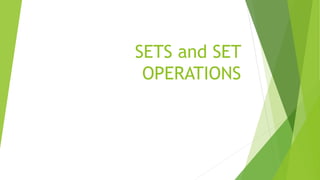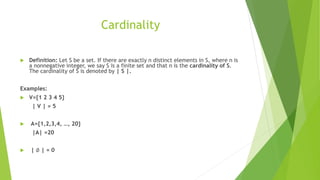Set and Set operations, UITM KPPIM DUNGUN
- 2. SET Definition: A set is a (unordered) collection of objects. These objects are sometimes called elements or members of the set. (Cantor's naive definition) Examples: Vowels in the English alphabet V = { a, e, i, o, u } First seven prime numbers. X = { 2, 3, 5, 7, 11, 13, 17 }
- 3. SET Representing a set: 1) Listing the members. 2) Definition by property, using set builder notation {x| x has property P} 3) Venn Diagram Example: Even integers between 50 and 63. 1) E = {50, 52, 54, 56, 58, 60, 62} 2) E = {x | 50 <= x < 63, x is an even integer} If enumeration of the members is hard we often use ellipses. Example: a set of positive integers between less than 100 1) A= {1,2,3 …, 99} 2) A = {x ∈ Z+ | x is odd and x < 100}
- 4. Sets in Discrete Math Natural numbers: N = {0,1,2,3, …} Integers Z = {…, -2,-1,0,1,2, …} Positive integers Z+ = {1,2, 3.…} Rational numbers Q = {p/q | p ∈ Z, q ∈ Z, q ≠ 0, the set of rational numbers} Real numbers R
- 5. Special Sets The universal set is denoted by U: the set of all objects under the consideration. The empty set is denoted as ∅ or { }.
- 6. Venn Diagram A set can be visualized using Venn Diagrams: V={ A, B, C } A B C U
- 7. Comparing Sets Subsets Superset Equal sets Disjoint sets Infinite sets
- 8. Subset Definition: A set A is said to be a subset of B if and only if every element of A is also an element of B. We use A ⊆ B to indicate A is a subset of B. Alternate way to define A is a subset of B: ∀x (x ∈ A) → (x ∈ B) A B
- 9. Subset Properties Theorem ∅ ⊆ S Empty set is a subset of any set. Theorem: S ⊆ S Any set S is a subset of itself
- 10. Superset Definition: A set B is a superset of another set A if all elements of the set A are elements of the set B. A⊃B
- 11. Equal Sets Definition: Two sets are equal if and only if they have the same elements. Example: {1,2,3} = {3,1,2} = {1,2,1,3,2} – listed more than one, they have the same elements Note: Duplicates don't contribute anything new to a set, so remove them. The order of the elements in a set doesn't contribute anything new.
- 12. Disjoint Sets Two sets are called disjoint if their intersection is the empty set. Example A = {1, 3, 5, 7, 9} and B = {2, 4, 6, 8, 10}. A ∩ B = ∅, A and B are disjoint A B U
- 13. Infinite Set Definition: A set is infinite if it is not finite. Examples: The set of natural numbers is an infinite set. N = {0, 1, 2, 3, ... } The set of real numbers is an infinite set.
- 14. Set Operators Union, ∪ Intersection, ∩ Complement, Difference, - Proper Subset, ⊂ Powerset, P Cardinality, |..| Cartesian Product, x
- 15. Union Definition: Let A and B be sets. The union of A and B, denoted by A ∪ B, is the set that contains those elements that are either in A or in B, or in both. Alternate: A ∪ B = { x | x ∈ A ∨ x ∈ B } Example: A = {1,2,3,6} B = { 2,4,6,9} A ∪ B = { 1,2,3,4,6,9 }
- 16. Intersection Definition: Let A and B be sets. The intersection of A and B, denoted by A ∩ B, is the set that contains those elements that are in both A and B. Alternate: A ∩ B = { x | x ∈ A ∧ x ∈ B } Example: A = {1,2,3,6} B = { 2, 4, 6, 9} A ∩B = { 2, 6 }
- 17. Complement Let U be the universal set. The complement of the set A, denoted by A, is the complement of A with respect to U. Therefore, the complement of the set A is U − A. A = {x ∈ U | x /∈ A}. Example A = {a, e, i, o, u} (where the universal set is the set of letters of the English alphabet) A = {b, c, d, f, g, h, j, k, l,m, n, p, q, r, s, t, v,w, x, y, z}.
- 18. Difference Definition: Let A and B be sets. The difference of A and B, denoted by A - B, is the set containing those elements that are in A but not in B. The difference of A and B is also called the complement of B with respect to A. A - B = { x | x ∈ A ∧ x ∉ B }. Example: A= {1,2,3,5,7} B = {1,5,6,8} A - B ={2,3,7}
- 19. A Proper Subset Definition: A set A is said to be a proper subset of B if and only if A ⊆ B and A ≠ B. We denote that A is a proper subset of B with the notation A ⊂ B. A B
- 20. A Proper Subset Example: A={1,2,3} B ={1,2,3,4,5} Is: A ⊂ B ? Yes.
- 21. Power Set Definition: Given a set S, the power set of S is the set of all subsets of S. The power set is denoted by P(S). Examples: Assume an empty set ∅ What is the power set of ∅ ? P(∅) = { ∅ } What is the cardinality of P(∅) ? |P(∅)| = 1 Assume set {1} P( {1} ) = { ∅, {1} } |P({1})| = 2
- 22. Power Set Assume {1,2} P( {1,2} ) = { ∅, {1}, {2}, {1,2} } |P({1,2} )| =4 Assume {1,2,3} P({1,2,3}) = {∅, {1}, {2}, {3}, {1,2}, {1,3}, {2,3}, {1,2,3} } |P({1,2,3} | = 8 If S is a set with |S| = n then | P(S) | = 2n..
- 23. Cardinality Definition: Let S be a set. If there are exactly n distinct elements in S, where n is a nonnegative integer, we say S is a finite set and that n is the cardinality of S. The cardinality of S is denoted by | S |. Examples: V={1 2 3 4 5} | V | = 5 A={1,2,3,4, …, 20} |A| =20 | ∅ | = 0
- 24. Cartesian Product Definition: Let S and T be sets. The Cartesian product of S and T, denoted by S x T, is the set of all ordered pairs (s,t), where s∈ S and t ∈ T. Hence, S x T = { (s,t) | s ∈ S ∧ t ∈ T}. Examples: S = {1,2} and T = {a,b,c} S x T = { (1,a), (1,b), (1,c), (2,a), (2,b), (2,c) } T x S = { (a,1), (a, 2), (b,1), (b,2), (c,1), (c,2) } Note: S x T ≠ T x S !!!!
- 25. Cardinality of Cartesian Product |S x T| = |S| * |T| Example: A= {John, Peter, Mike} B ={Jane, Ann, Laura} A x B= {(John, Jane), (John, Ann) , (John, Laura), (Peter, Jane), (Peter, Ann) , (Peter, Laura) , (Mike, Jane) , (Mike, Ann) , (Mike, Laura)} |A x B| = 9 |A|=3, |B|=3 -> |A||B|= 9 Definition: A subset of the Cartesian product A x B is called a relation from the set A to the set B.
- 26. Set Identities
- 27. Set Identities Set identities can be proved using membership tables. List each combination of sets that an element can belong to. Then show that for each such a combination the element either belongs or does not belong to both sets in the identity. Example Prove: (A ∩ B) = A ∪ B A B A B A ∩ B A ∪ B 1 1 0 0 0 0 1 0 0 1 1 1 0 1 1 0 1 1 0 0 1 1 1 1


























